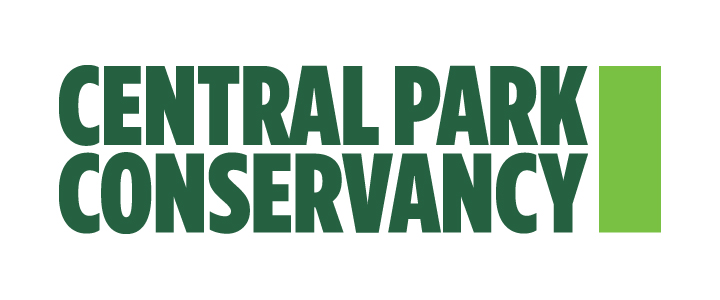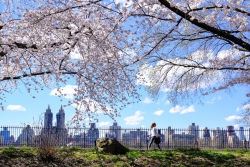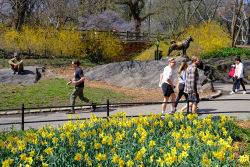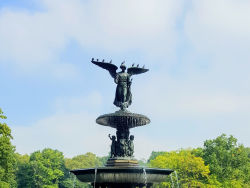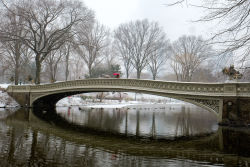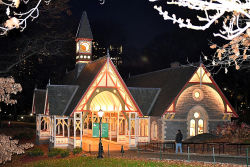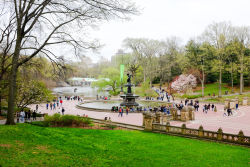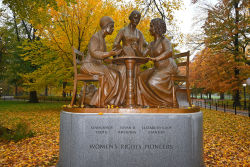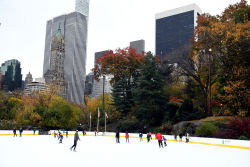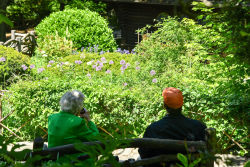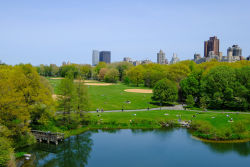Central Park
The Dairy
When the Board of Commissioners of Central Park organized the design competition for a new park in 1857, the rules did not stipulate that the plans include any features for children. After a few years, however, the Board decided to set up a "children’s district" with attractions specifically intended for younger park visitors. By 1872, this district comprised the Carousel, a playground (now the Heckscher Ball Fields and Playground), the Children’s Cottage (since destroyed), the Kinderberg Rustic Shelter (now the Chess and Checkers House), and the Dairy.
Calvert Vaux (1824-1895) designed the Dairy, which is constructed of Manhattan schist and sandstone. The structure incorporates many features typical of Gothic Revival architecture. The windows of the Great Hall and the spire recall a country church. The steep pitched roof and loggia (open-air porch) evoke images of a mountain chalet. Finally, the framing of the beams and gambrel ceilings resemble those of a rustic barn. Situated and designed to catch the cool breezes coming off the pond (the site of the present Wollman Rink), the bucolic loggia provides respite from the summer heat.
Central Park’s designers Calvert Vaux and Frederick Law Olmsted (1822-1903) planned the Dairy as a place of respite to maximize summer breezes. It was to feature a refreshment stand with light snacks and fresh milk for children. In the 1850s, a rash of tainted milk was sold in New York. This milk, known as swill milk, was taken from cows which had fed from swill—mash leftover from the beer brewing process. In the mid-1860s, the production and sale of milk became strictly regulated. As a result, most of the milk consumed in New York City was shipped in from upstate farms, as inner-city dairies became less common and less able to meet the heightened standards. Despite the regulations, milk quality remained a concern to social reformers and health advocates. Olmsted and Vaux may have been thinking of those recent scares when they drew up the plans for the Dairy.
The Dairy was also to include a kiosk to loan out toys, but this became the province of the nearby Children’s Cottage. When finally opened to the public in 1871, the Dairy barely resembled Olmsted and Vaux’s original plan. Park officials from the Tweed Administration had installed a public restaurant priced to attract middle-class New Yorkers. By the time the restaurant closed in the 1950s, the Dairy’s dilapidated loggia had been torn down, and the stone building had become a maintenance shed.
In 1979, after years of vacancy, designer James Lamantia and Weisberg Castro Associates restored the interior of the Dairy. It reopened as the park’s first visitor center under the new Central Park Administration. Two years later, the loggia was restored to its Victorian splendor and the Central Park Conservancy took over management of the Dairy. The Conservancy, a not-for-profit organization founded in 1980, manages Central Park under contract with Parks. Today, the Dairy houses a permanent exhibit on the history and design of the park.
Check out your park's Vital Signs
Clean & Safe
Green & Resilient
Empowered & Engaged Users
Share your feedback or learn more about how this park is part of a
Vital Park System
Contacts
Central Park Information: (212) 310-6600
Central Park Information (for the Hearing Impaired): (800) 281-5722
Belvedere Castle, The Henry Luce Nature Observatory: (212) 772-0210
The Charles A. Dana Discovery Center: (212) 860-1370
The Dairy Visitor Center and Gift Shop: (212) 794-6564
North Meadow Recreation Center: (212) 348-4867
Loeb Boathouse (Bike rentals, boat rentals & gondolas): (212) 517-2233
Carousel: (212) 879-0244
Fishing at Harlem Meer (Catch & Release): (212) 860-1370
Harlem Meer Performance Festival: (212) 860-1370
Horseback Riding - Claremont Stables: (212) 724-5100
Metropolitan Opera (Performances on the Great Lawn): (212) 362-6000
New York Philharmonic (Performances on the Great Lawn): (212) 875-5709
Shakespeare in the Park - The Public Theater at the Delacorte Theater: (212) 539-8655
Central Park SummerStage: (212) 360-2777
Swedish Cottage Marionette Theater: (212) 988-9093
Tennis: (212) 280-0205
Weddings, Ceremonies and Photography at the Conservatory Garden: (212) 360-2766
Wildlife Center & Tisch Children's Zoo: (212) 439-6500

